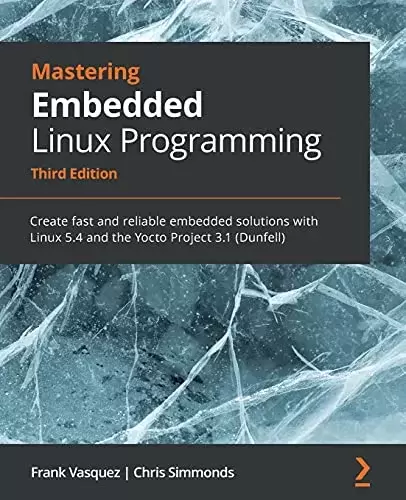
Book Description
Harness the power of Linux to create versatile and robust embedded solutions
Key Features
- Learn how to develop and configure robust embedded Linux devices
- Explore the new features of Linux 5.4 and the Yocto Project 3.1 (Dunfell)
- Discover different ways to debug and profile your code in both user space and the Linux kernel
Book Description
Embedded Linux runs many of the devices we use every day. From smart TVs and Wi-Fi routers to test equipment and industrial controllers, all of them have Linux at their heart. The Linux OS is one of the foundational technologies comprising the core of the Internet of Things (IoT).
This book starts by breaking down the fundamental elements that underpin all embedded Linux projects: the toolchain, the bootloader, the kernel, and the root filesystem. After that, you will learn how to create each of these elements from scratch and automate the process using Buildroot and the Yocto Project. As you progress, the book explains how to implement an effective storage strategy for flash memory chips and install updates to a device remotely once it’s deployed. You’ll also learn about the key aspects of writing code for embedded Linux, such as how to access hardware from apps, the implications of writing multi-threaded code, and techniques to manage memory in an efficient way. The final chapters demonstrate how to debug your code, whether it resides in apps or in the Linux kernel itself. You’ll also cover the different tracers and profilers that are available for Linux so that you can quickly pinpoint any performance bottlenecks in your system.
By the end of this Linux book, you’ll be able to create efficient and secure embedded devices using Linux.
What you will learn
- Use Buildroot and the Yocto Project to create embedded Linux systems
- Troubleshoot BitBake build failures and streamline your Yocto development workflow
- Update IoT devices securely in the field using Mender or balena
- Prototype peripheral additions by reading schematics, modifying device trees, soldering breakout boards, and probing pins with a logic analyzer
- Interact with hardware without having to write kernel device drivers
- Divide your system up into services supervised by BusyBox runit
- Debug devices remotely using GDB and measure the performance of systems using tools such as perf, ftrace, eBPF, and Callgrind
Who this book is for
If you’re a systems software engineer or system administrator who wants to learn Linux implementation on embedded devices, then this book is for you. Embedded systems engineers accustomed to programming for low-power microcontrollers can use this book to help make the leap to high-speed systems on chips that can run Linux. Anyone responsible for developing new hardware that needs to run Linux will also find this book useful. Basic working knowledge of the POSIX standard, C programming, and shell scripting is assumed.
Table of Contents
- Starting Out
- Learning about Toolchains
- All about Bootloaders
- Configuring and Building the Kernel
- Building a Root Filesystem
- Selecting a Build System
- Developing with Yocto
- Yocto Under the Hood
- Creating a Storage Strategy
- Updating Software in the Field
- Interfacing with Device Drivers
- Prototyping with Breakout Boards
- Starting Up – The init Program
- Starting with BusyBox runit
- Managing Power
- Packaging Python
- Learning about Processes and Threads
- Managing Memory
- Debugging with GDB
- Profiling and Tracing
- Real-Time Programming
中文:
书名:Mastering Embedded Linux Programming, 3rd Edition
利用Linux的强大功能创建功能强大的嵌入式解决方案
Key Features
- 了解如何开发和配置健壮的嵌入式Linux设备
- 探索Linux5.4和Yocto Project 3.1(Dunfell)的新特性
- 了解在用户空间和Linux内核中调试和分析代码的不同方法
Book Description
嵌入式Linux可以运行我们每天使用的许多设备。从智能电视和Wi-Fi路由器到测试设备和工业控制器,所有这些设备都以Linux为核心。Linux操作系统是构成物联网(IoT)核心的基础技术之一。
本书首先分析了支撑所有嵌入式Linux项目的基本元素:工具链、引导加载程序、内核和根文件系统。之后,您将学习如何从头开始创建这些元素,并使用Buildroot和Yocto项目自动执行该过程。随着你的进步,这本书解释了如何为闪存芯片实施有效的存储策略,并在设备部署后远程安装更新。您还将了解为嵌入式Linux编写代码的关键方面,例如如何从应用程序访问硬件、编写多线程代码的含义以及高效管理内存的技术。最后几章演示了如何调试代码,无论它驻留在应用程序中还是在Linux内核本身中。您还将介绍可用于Linux的不同跟踪程序和分析器,以便您可以快速定位系统中的任何性能瓶颈。
在这本Linux书的最后,您将能够使用Linux创建高效、安全的嵌入式设备。
你将学到什么
- 使用Buildroot和Yocto项目创建嵌入式Linux系统
- 排除BitBake构建失败并简化您的Yocto开发工作流
- 使用Mender或Balena在现场安全更新物联网设备
- 通过读取原理图、修改设备树、焊接接线板和使用逻辑分析仪探测引脚来制作外围设备添加的原型
- 无需编写内核设备驱动程序即可与硬件交互
- 将您的系统划分为由BusyBox Runit监督的服务
- 使用gdb远程调试设备,并使用perf、ftrace、eBPF和Callgrind等工具测量系统的性能
这本书是为谁而写的
如果你是一名系统软件工程师或系统管理员,想要学习Linux在嵌入式设备上的实现,那么这本书是为你准备的。习惯于为低功耗微控制器编程的嵌入式系统工程师可以使用这本书来帮助实现向可以运行Linux的芯片上的高速系统的飞跃。任何负责开发需要运行Linux的新硬件的人也会发现这本书很有用。本文假定您具有POSIX标准、C编程和外壳脚本的基本工作知识。
Table of Contents
- Starting Out
- 了解工具链
- 所有关于引导加载器
- 配置和构建内核
- 构建根文件系统
- 选择构建系统
- 与Yocto一起发展
- 引擎盖下的尤克托
- Creating a Storage Strategy
- Updating Software in the Field
- Interfacing with Device Drivers
- Prototyping with Breakout Boards
- Starting Up – The init Program
- 从BusyBox Runit开始
- Managing Power
- Packaging Python
- 了解进程和线程
- Managing Memory
- Debugging with GDB
- 分析和跟踪
- Real-Time Programming
评论前必须登录!
注册